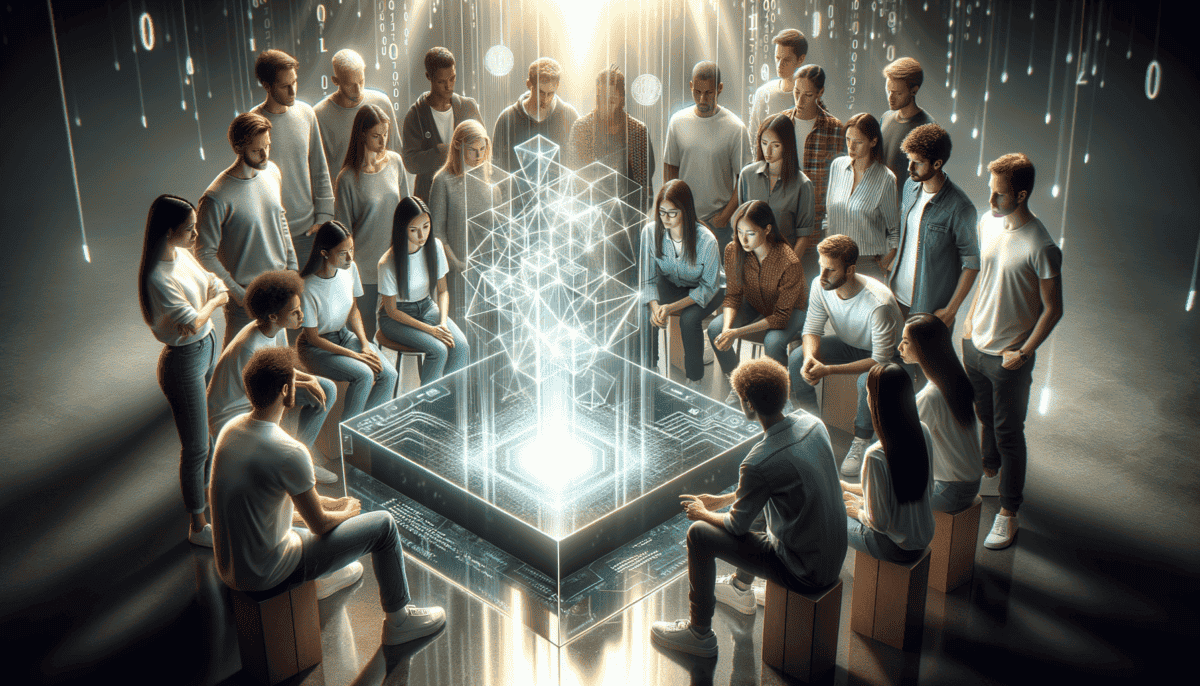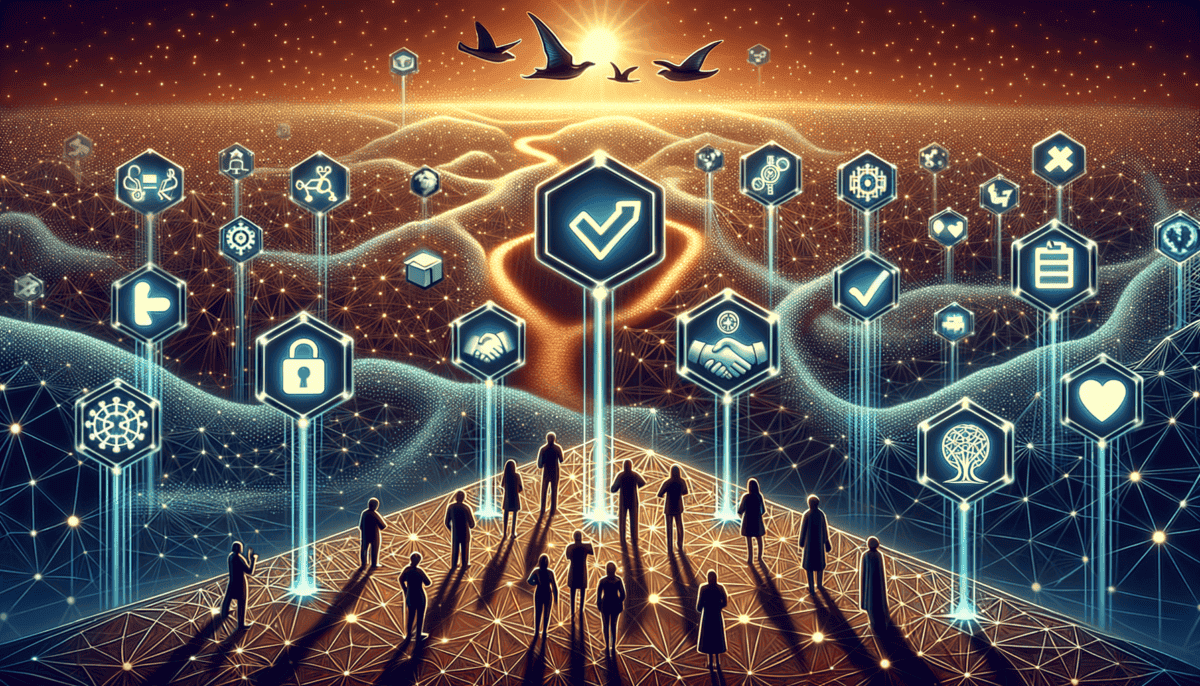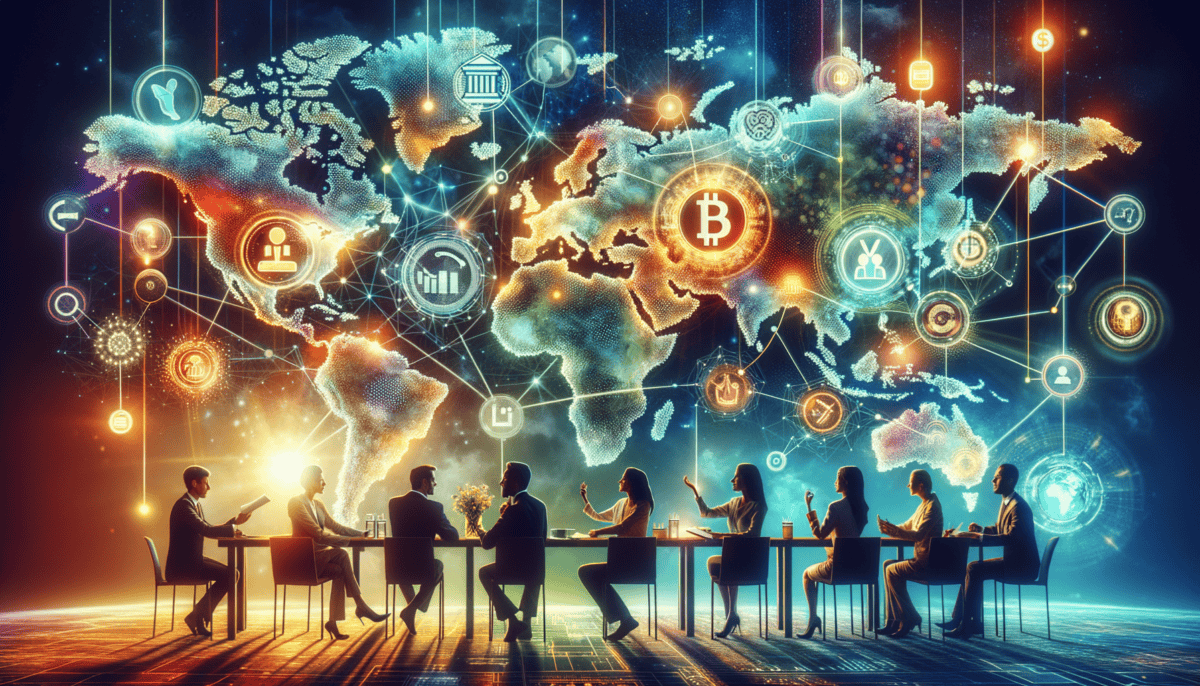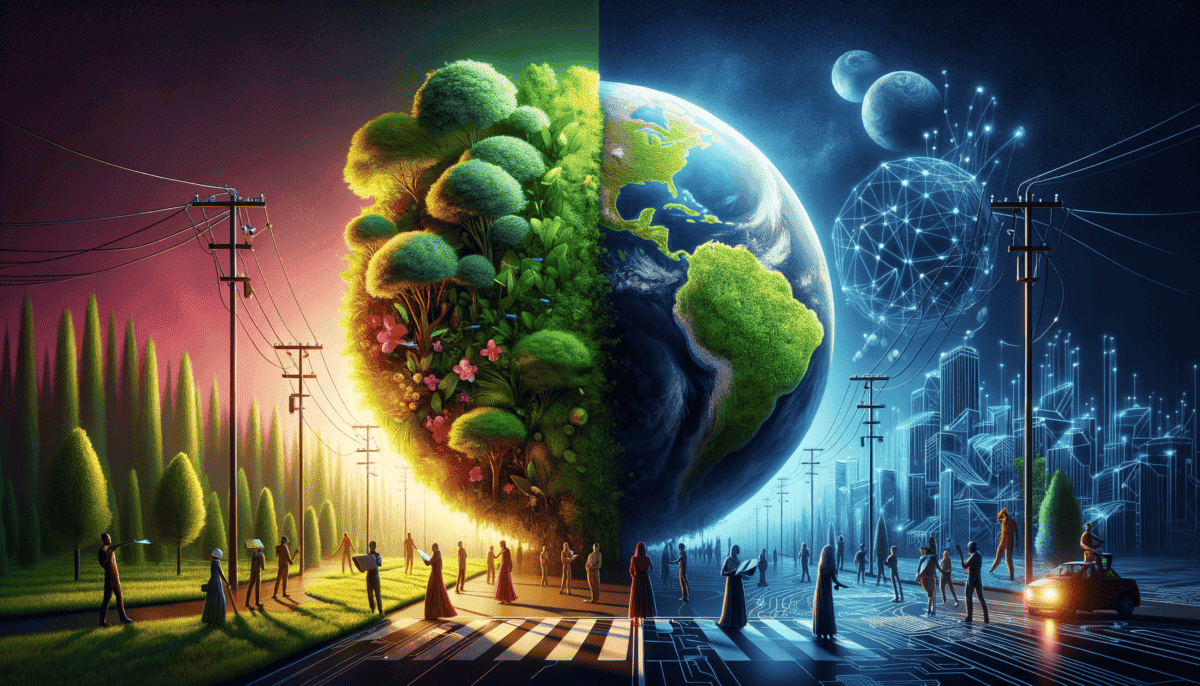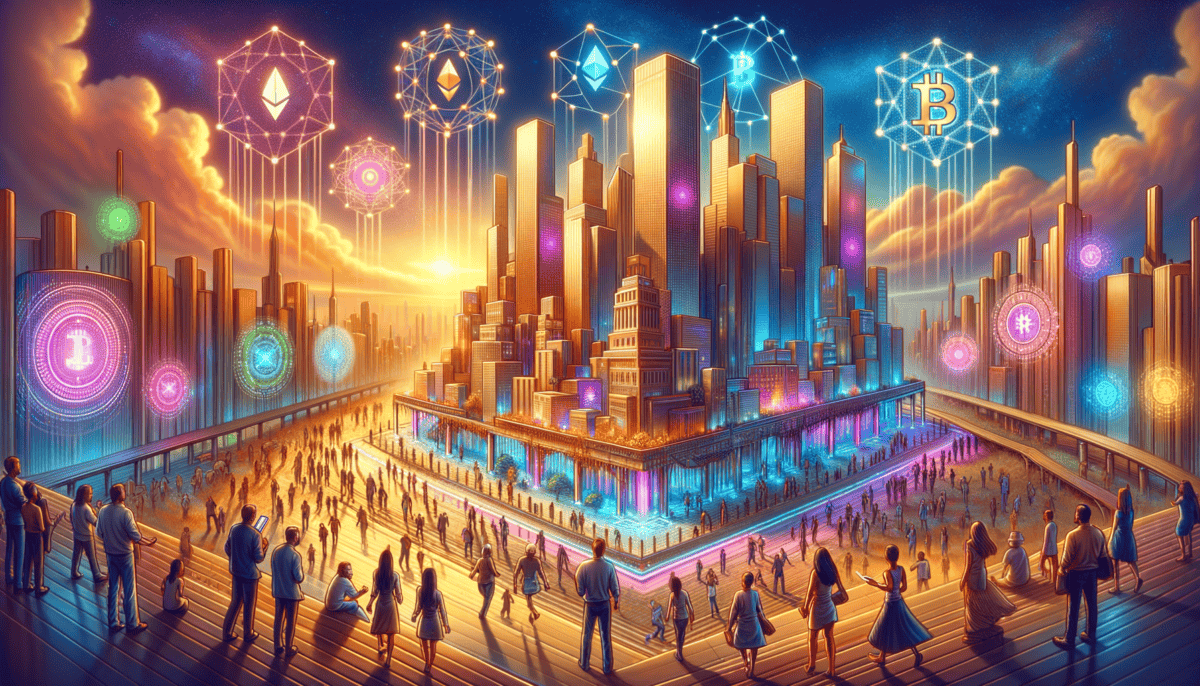The Digital Spark
On a quiet morning in 2008, someone special woke up with a big idea. Nobody knew their real name, so they called themselves Satoshi Nakamoto. Satoshi wanted to make money work better for everyone.
"The old way of using money isn't fair," Satoshi thought while typing on their computer. "Banks have too much control. We need something new!"
Little Alex, a curious 8-year-old, sat with her dad as he explained what Satoshi made. "Think of it like a magical diary," her dad said, smiling. "But instead of keeping secrets, it keeps track of money. And the best part? Everyone can see what's written in it!"
"But how does it work, Dad?" Alex asked, her eyes wide with wonder.
"Well, sweetie, imagine you and your friends have a special notebook. When someone shares their candy, you all write it down. Nobody can cheat because everyone has the same notebook!"
This special notebook had a fancy name – blockchain!
The news about Bitcoin spread like wildfire across the internet! People from all over the world started getting excited. Some said:
"This could change everything!"
"Finally, money that belongs to everyone!"
"It's like magic, but with computers!"
One day, a group of computer experts gathered online to test Bitcoin. They sent money to each other without using banks!
"Look!" shouted Maria, a young programmer. "I just sent money to Juan in Spain, and it took seconds!" Her friends watched in amazement as the transaction appeared on their screens.
What made Bitcoin special?
• It worked without banks
• Nobody could fake it
• It belonged to everyone
• You could use it anywhere in the world
Young tech wizards stayed up late at night, learning about this new technology. They dreamed of ways to make it even better. "This is just the beginning," they would say, their faces glowing in the light of their computer screens.
As the sun set on that first year of Bitcoin, more and more people joined the exciting adventure. They didn't know it yet, but they were part of something that would grow bigger than anyone imagined.
Satoshi's last message to the world was simple: "I've built the first bridge. Now it's up to you to build more." Then, just like magic, Satoshi disappeared, leaving behind a gift that would change the world forever.
The story of blockchain was just beginning, and new heroes were ready to take it even further. Young minds buzzed with questions and ideas, eager to discover what other amazing things this technology could do.
The Cryptographic Quest
Meet Maya, a bright 12-year-old who loves solving puzzles. She and her best friend Tom were about to learn something amazing about blockchain from their computer teacher, Ms. Rodriguez.
“Today, we’re going to play a special game,” Ms. Rodriguez said with a twinkle in her eye. “It’s called ‘The Block Chain Game!'”
The class sat in a circle, each holding a piece of paper. Ms. Rodriguez explained, “When someone writes something on their paper, everyone needs to copy it. This way, we all have the same information!”
“But what if someone tries to cheat?” Tom asked, raising his hand.
“That’s the magic of blockchain!” Ms. Rodriguez smiled. “Everyone can see what’s written, so it’s hard to cheat!”
“It’s like having a hundred eyes watching your piggy bank!” Maya giggled.
Ms. Rodriguez brought out some building blocks to show how blockchain works:
- Block 1 connects to Block 2
- Block 2 connects to Block 3
- Each block knows about the blocks before it
- No one can change old blocks without everyone knowing
“Wow!” exclaimed Maya. “It’s like a never-ending game of telephone, but nobody can mess up the message!”
Later that day, Maya showed her little brother how miners work:
“Imagine you’re solving a super hard puzzle,” she explained. “When you finish it, you get a golden star! That’s what miners do – they solve puzzles and get rewards!” ⭐
The whole class got excited about being blockchain explorers!
They even made their own classroom blockchain:
Library books logged on Block 2
Class achievements recorded on Block 3
“Remember,” Ms. Rodriguez said, “blockchain is like a trusted friend who never forgets and always tells the truth.”
As the school day ended, Maya and Tom couldn’t stop talking about their blockchain adventure. They dreamed of growing up to build even better blockchains that could help more people.
“Maybe one day,” Maya said to Tom, “we’ll make a blockchain that can do something nobody has thought of yet!”
The next morning, more students brought ideas for their classroom blockchain. The excitement was spreading, just like the technology itself was spreading across the world. Their young minds were already thinking about what amazing things they could do with this new tool.
Beyond Currency
Maya and Tom burst into class, buzzing with excitement. “Ms. Rodriguez! We found something amazing!” Maya waved her tablet in the air. “Blockchain isn’t just for money!”
“That’s right!” Ms. Rodriguez beamed. “Today we’re going to explore the magical ways blockchain helps people everywhere!”
The class gathered around as Ms. Rodriguez pulled out a basket of fresh apples. “Let’s play ‘Apple Adventure’ to see how blockchain works in real life!”
“First, Farmer Fred picks the apple,” she said, holding up a shiny red apple. “He puts a special tag on it that tells us where it came from.”
“It’s like giving the apple its own diary!” Tom laughed.
Maya picked up an apple and pretended to scan it. “Look! This apple came from Happy Valley Farm on Monday. Then it rode on a cool truck to the store on Tuesday!”
Ms. Rodriguez then showed the class other amazing uses for blockchain:
- Doctors can share patient records safely
- Artists can protect their digital art
- People can vote from home securely ️
- Scientists can track endangered animals
“Let’s make our own school supply chain!” suggested Tom. The class got excited and started planning.
Sarah, a quiet girl in the back, raised her hand. “Could we use blockchain to help the animal shelter keep track of pets?”
“What a wonderful idea!” Ms. Rodriguez clapped. “Each pet could have their own special blockchain story!”
The class brainstormed more ways to help their community with blockchain:
Monitor the school garden growth
Share books in a neighborhood library
Create a digital art gallery
“I want to build blockchains that help doctors!” Maya declared. “Then they can take better care of people!”
Tom nodded enthusiastically. “And I want to make sure all food is safe to eat by tracking it!”
Ms. Rodriguez watched proudly as her students imagined new ways to use blockchain. “Remember,” she said, “blockchain is like a helper that can make many things better and safer.”
After school, Maya and Tom started drawing plans for their future blockchain projects. They knew that this technology could do so much more than just handle money. It could help make the world a better place!
More students joined their blockchain club each day. They were discovering that when you combine caring hearts with powerful technology, amazing things can happen. Their journey into the world of blockchain was just beginning, and they couldn’t wait to see what they would discover next.
Global Disruption
The classroom buzzed with energy as Ms. Rodriguez pointed to a big world map. “Today, we’re going on a special journey around the world to see how blockchain is changing everything!”
“Look at all those pins on the map!” Sarah exclaimed, noticing colorful markers scattered across continents.
Tom raised his hand excitedly. “My cousin in Japan says they use blockchain to make sure nobody copies their favorite cartoon characters!”
“That’s right!” Ms. Rodriguez smiled. “And in Africa, farmers use blockchain to sell their crops directly to buyers!”
Maya jumped up from her seat. “But my uncle says some banks don’t like blockchain because it’s different from their old way of doing things.”
The class played a game called “Around the World with Blockchain.” Each student became a different country:
- Japan: Using blockchain for cartoon movies
- Kenya: Helping farmers sell food
- Sweden: Making sure votes are counted right
- Australia: Tracking baby koala bears
“I want to be India!” Sarah shouted. “They’re using blockchain to make sure kids get good food at school!”
Ms. Rodriguez brought out a special guest on the computer screen. It was Dr. Lee, a blockchain expert from Singapore!
“Hello, young innovators!” Dr. Lee waved. “In my country, we use blockchain to make sure our shipping boats know exactly where to go!”
The children’s eyes grew wide with wonder.
"It's like a huge puzzle," Dr. Lee explained. "Every country adds its own special piece to make blockchain better!"
But then Maya asked a tough question: “What about countries that don’t have many computers?”
The class decided to start a special project. They would help other kids learn about blockchain:
“We can make simple pictures to explain it!” Tom suggested.
“And write stories in different languages!” added Maya.
“Maybe we can even make a blockchain game!” Sarah chimed in.
Ms. Rodriguez watched as her students drew pictures and wrote stories about blockchain. They were becoming little ambassadors, ready to share their knowledge with the world.
“Remember,” she said softly, “big changes start with small steps. Each of you can help make blockchain work for everyone.”
As the school day ended, the children couldn’t stop talking about their new global blockchain friends. They knew that even though some people might be scared of new things, blockchain was bringing people together in wonderful ways.
Maya and Tom stayed after class, planning their next big idea. Could they create a blockchain project that would help kids everywhere talk to each other and share their stories? The adventure was getting more exciting every day!
The Environmental Crossroads
Maya stared out the classroom window at the solar panels gleaming on the school’s roof. “Ms. Rodriguez, how much power does blockchain use?” she asked, twirling her pencil thoughtfully.
“That’s a very important question, Maya!” Ms. Rodriguez walked to the front of the class. She held up a picture of a big computer room filled with machines. “These are special blockchain computers. They work super hard and need lots of electricity.”
Tom’s hand shot up. “Just like my video games use power when I play too long?”
“Much more than that,” Ms. Rodriguez smiled. “Imagine if everyone in our town was playing video games at the same time!”
Sarah frowned. “But isn’t that bad for the Earth?”
Ms. Rodriguez pulled out a special map showing different kinds of power around the world:
- ☀️ Solar power from the sun
- Wind power from big turbines
- Water power from rivers
- Earth-friendly power choices
“Look at Iceland!” she pointed. “They use special heat from underground to power their blockchain computers!”
The class gathered around a small experiment Ms. Rodriguez had set up. She had two toy houses – one with regular lights and one with solar-powered lights.
“We can make choices that help the Earth while using blockchain,” she explained, turning on the solar lights.
Maya jumped up with an idea. “What if we made a garden on the school roof next to the solar panels?”
“And we could use blockchain to track how much power we save!” added Tom excitedly.
Sarah grabbed her notebook. “We could share our ideas with other schools too!”
Ms. Rodriguez invited a special guest to class – Dr. Green, who worked on making blockchain use less power. She appeared on the big screen with a friendly wave.
“Hello, young Earth warriors!” Dr. Green beamed. “I’m so excited to hear your ideas about helping blockchain and nature work together!”
The students shared their drawings and plans. Dr. Green looked impressed.
“These are wonderful ideas!” she exclaimed. “Did you know some blockchain computers now run on sunshine power?”
By the end of the day, the classroom walls were covered with colorful posters showing how blockchain could help save energy. Maya and Tom had even started planning a school fair to teach others about green blockchain technology.
“Remember,” Ms. Rodriguez said as they packed up their bags, “every small step toward helping our Earth matters. We can make blockchain work in harmony with nature!”
The children left school that day feeling like real environmental heroes. They knew that solving big problems meant working together and thinking creatively. Tomorrow would bring new challenges, but they were ready to face them with their green ideas and bright spirits!
The Future Unchained
The sun peeked through the classroom windows as Ms. Rodriguez unveiled a special surprise. “Today, we’re going to talk about what blockchain might do in the future!”
“Look at this!” Maya pointed excitedly at the computer screen. Kids from Japan, Brazil, and Kenya were sharing their own blockchain projects.
Tom bounced in his seat. “They’re using our ideas about solar power!”
“And they’ve added new ideas too,” Sarah added, her eyes wide with wonder. “A school in Australia is using blockchain to protect koalas!”
Ms. Rodriguez smiled proudly. “Let’s imagine what else blockchain could do in the future. Close your eyes and dream big!”
One by one, they shared their dreams:
- Hospitals that share information to help sick people faster
- Trees that tell us when they need water
- Art that everyone can see and enjoy together
- Food that tells us exactly where it came from
“The future is like a story we all write together,” Ms. Rodriguez explained. “And blockchain helps us write it better!”
“Your Green Chain Project is inspiring our whole city!” the mayor announced. “We’re going to use your ideas to make our town better!”
The class erupted in cheers. Maya hugged Sarah, and Tom did a happy dance.
Dr. Green joined them again, this time with more scientists from around the world. They formed a special team called “The Future Builders.”
“Together, we can solve big problems,” Dr. Green said. “Blockchain is like a bridge to tomorrow.”
The class started a new project – a time capsule filled with their blockchain dreams. They would open it in ten years to see which ones came true!
Maya wrote about clean oceans. Tom dreamed of flying cars that run on sunshine. Sarah imagined schools where kids from every country could learn together through blockchain.
“Remember,” Ms. Rodriguez said softly, “the best technology helps everyone and hurts no one.”
The children nodded solemnly. They had learned so much about blockchain – its mysteries, its power, and its promise. But most importantly, they had learned about working together to make good things happen.
Years from now, people would remember how a small class of curious kids helped change the world. Their Green Chain Journal would inspire others to dream big and work hard.
The bell rang, but nobody wanted to leave. The future was calling, and it was full of endless possibilities. With blockchain as their tool and hope as their guide, these young innovators were ready to build a better tomorrow – one block at a time! ✨


